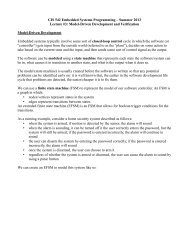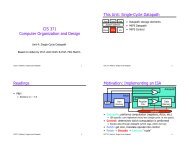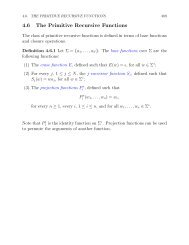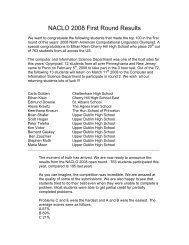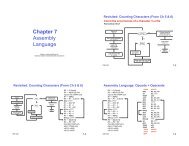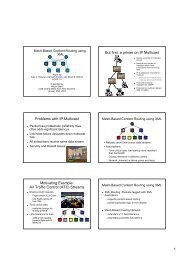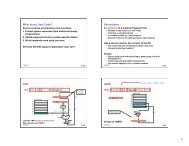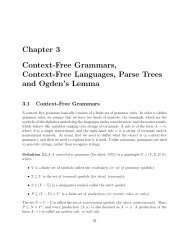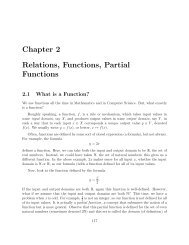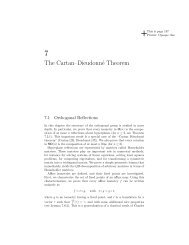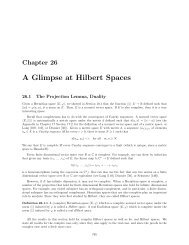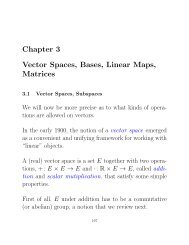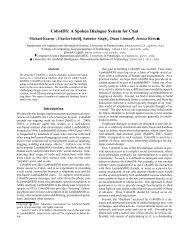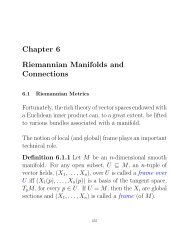Contagion in Networks
Contagion in Networks
Contagion in Networks
Create successful ePaper yourself
Turn your PDF publications into a flip-book with our unique Google optimized e-Paper software.
<strong>Contagion</strong> <strong>in</strong> <strong>Networks</strong><br />
Networked Life<br />
NETS 112<br />
Fall 2013<br />
Prof. Michael Kearns
“Epidemos”<br />
• Forest fire simulation:<br />
– grid of forest and vacant cells<br />
– fire always spreads to adjacent four cells<br />
• “perfect” stick<strong>in</strong>ess or <strong>in</strong>fectiousness<br />
– connectivity parameter:<br />
• probability of forest<br />
– fire will spread to all of connected component of source<br />
– tip when forest ~ 0.6<br />
– clean mathematical formalization (e.g. fraction burned)<br />
• Viral spread simulation:<br />
– population on a grid network, each with four neighbors<br />
– stick<strong>in</strong>ess parameter:<br />
• probability of pass<strong>in</strong>g disease<br />
– connectivity parameter:<br />
• probability of rewir<strong>in</strong>g local connections to random long-distance<br />
– no long distance connections: tip at stick<strong>in</strong>ess ~ 0.3<br />
– at rewir<strong>in</strong>g = 0.5, often tip at stick<strong>in</strong>ess ~ 0.2
“Mathematiz<strong>in</strong>g” the Forest Fire<br />
• Start with a regular 2-dimensional grid network<br />
– this represents a complete forest<br />
• Delete each vertex (and its edges) with probability p (<strong>in</strong>dependently)<br />
– this represents random “clear-cutt<strong>in</strong>g” or natural fire breaks<br />
• Choose a random rema<strong>in</strong><strong>in</strong>g vertex v<br />
– this is my campsite<br />
• Q: What is the expected size of v’s connected component?<br />
– this is how much of the forest is go<strong>in</strong>g to burn
“Mathematiz<strong>in</strong>g” the Epidemic<br />
• Start with a regular 2-dimensional grid network<br />
– this represents a dense population with “local” connections (neighbors)<br />
• Rewire each edge with probability p to a random dest<strong>in</strong>ation<br />
– this represents “long-distance” connections (chance meet<strong>in</strong>gs)<br />
• Choose a random rema<strong>in</strong><strong>in</strong>g vertex v<br />
– this is an <strong>in</strong>fection; spreads probabilistically to each of v’s neighbors<br />
• Fraction killed more complex:<br />
– depends on both size and structure of v’s connected component<br />
• Important theme:<br />
– mix<strong>in</strong>g regular, local structure with random, long-distance connections
Some Remarks on the Demos<br />
• Connectivity patterns were either local or random<br />
– will eventually formalize such models<br />
– what about other/more realistic structure?<br />
• Tipp<strong>in</strong>g was <strong>in</strong>herently a statistical phenomenon<br />
– probabilistic nature of connectivity patterns<br />
– probabilistic nature of disease spread<br />
– model likely properties of a large set of possible outcomes<br />
– can model either <strong>in</strong>herent randomness or variability<br />
• Formaliz<strong>in</strong>g tipp<strong>in</strong>g <strong>in</strong> the forest fire demo:<br />
– might let grid size N <strong>in</strong>f<strong>in</strong>ity, look at fixed values of p<br />
– is there a threshold value q:<br />
• p < q expected fraction burned < 1/10<br />
• p > q expected fraction burned > 9/10
Structure and Dynamics Case Study:<br />
A “<strong>Contagion</strong>” Model of Economic Exchange<br />
• Imag<strong>in</strong>e an undirected, connected network of <strong>in</strong>dividuals<br />
– no model of network formation<br />
• Start each <strong>in</strong>dividual off with some amount of currency<br />
• At each time step:<br />
– each vertex divides their current cash equally among their neighbors<br />
– (or chooses a random neighbor to give it all to)<br />
– each vertex thus also receives some cash from its neighbors<br />
– repeat<br />
• A transmission model of economic exchange --- no “rationality”<br />
• Q: How does network structure <strong>in</strong>fluence outcome?<br />
• A: As time goes to <strong>in</strong>f<strong>in</strong>ity:<br />
– vertex i will have fraction deg(i)/D of the wealth; D = sum of deg(i)<br />
– degree distribution entirely determ<strong>in</strong>es outcome!<br />
– “connectors” are the wealthiest<br />
– not obvious: consider two degree = 2 vertices…<br />
• How does this outcome change when we consider more “realistic” dynamics?<br />
– e.g. we each have goods available for trade/sale, preferred goods, etc.<br />
• What other processes have similar dynamics?<br />
– look<strong>in</strong>g ahead: models for web surf<strong>in</strong>g behavior



